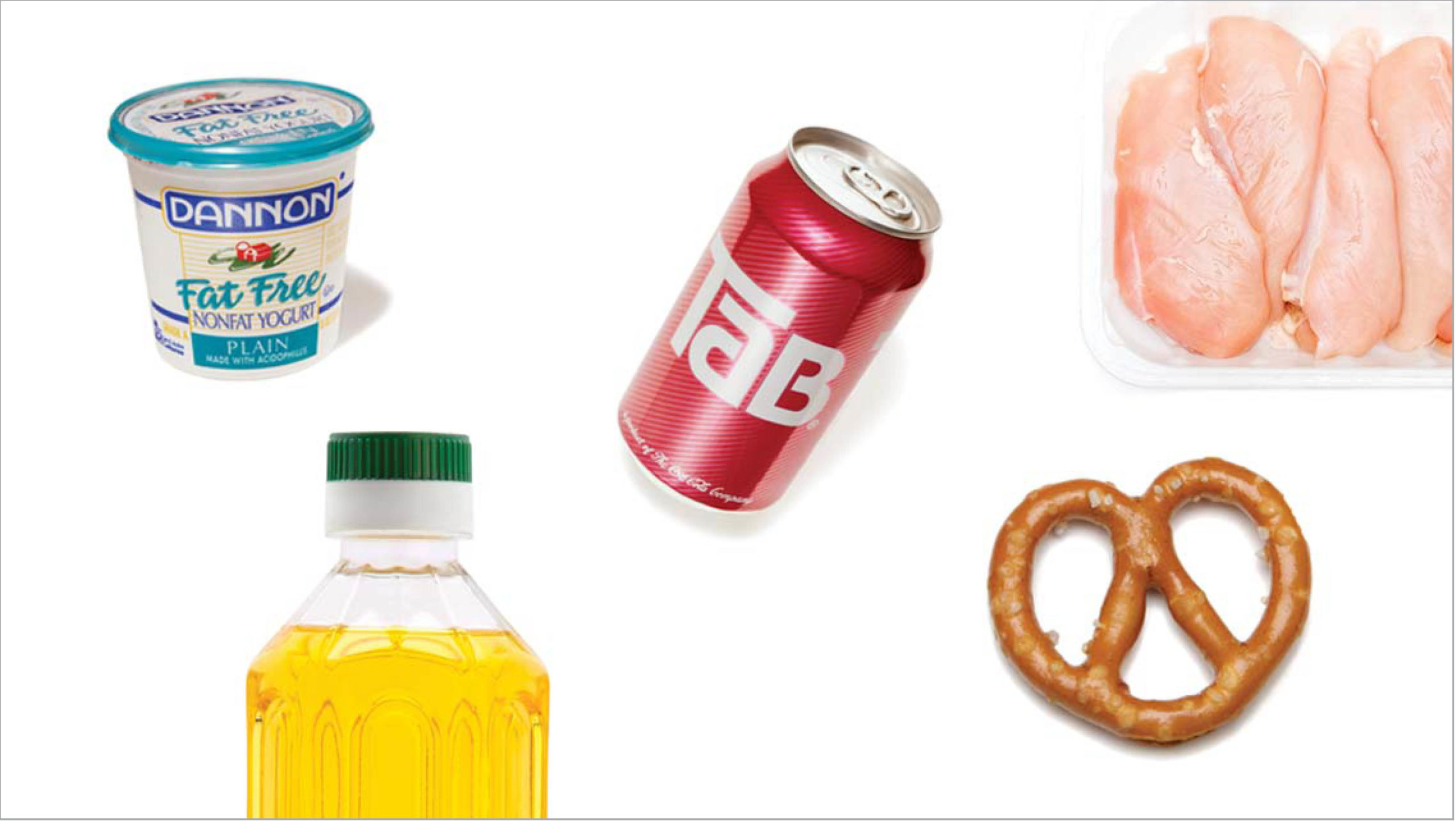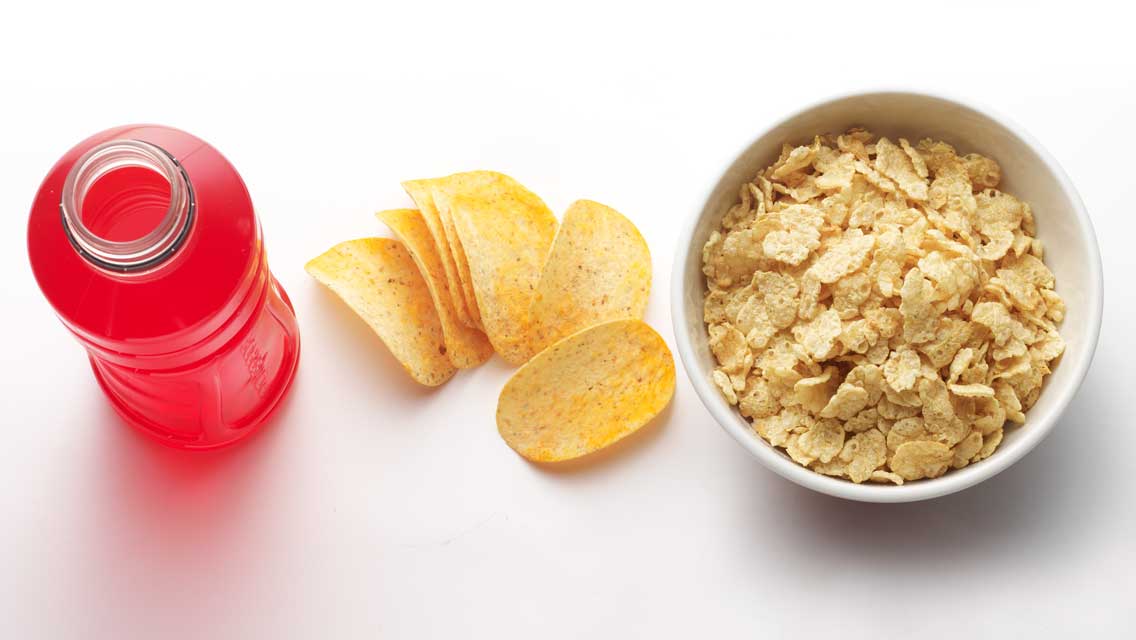The 1980s are notorious for the introduction (and unfettered embrace) of all things fat- and sugar-free. Think Diet Coke, Entenmann’s fat-free pastries, and TCBY. Unfortunately, it’s a trend that’s still alive and well in a lot of today’s kitchens and restaurants.
This mass migration to nutritionally empty, nonsatiating fake foods over the past several decades, say many experts, is a big part of what caused America’s obesity rates to double among adults and triple among youths. So, how do we reverse course? You might be surprised to learn that it’s easier — and a lot more enjoyable — than you might imagine.
To prove the point, we invited a handful of top-notch nutritionists and nutrition educators to identify some of the myths we’ve been sold by the fake-food industry and “diet” experts. In the end, they say, eating real foods — even those that may include a fair bit of fat and sugar — is much better for our health than the low-cal, lab-created stuff we may have been choking down since the ’80s.
“You can eat sugar, fat and salt if you’re willing to do it right,” says Hana Feeney, MS, RD, a nutrition counselor at the University of Arizona in Tucson. Just remember that the key to all of these substitutions is moderation. “One of the reasons people moved away from decadent foods, like butter, is because to eat them in a healthful way, you must eat smaller amounts less often,” says Feeney. “To be successful with this, slow down and eat with a heightened sense of awareness and enjoyment.”
Our Panel of Experts:
- Hana Feeney, MS, RD, is a nutrition counselor at the University of Arizona in Tucson.
- Julie Starkel, MS, RD, is an integrative and functional medicine nutritionist in Seattle.
- Maggie Ward, MS, RD, LDN, is the nutrition director of the UltraWellness Center in Lenox, Mass..
- Kristin Wartman is a certified nutrition educator and writer in Brooklyn, N.Y.
Here’s to having your cake and eating it, too (as long as it’s made with real butter and sugar, that is).
Old School: Industrial Vegetable Oils
Our experts are hard-pressed to find something positive to say about commercially processed vegetable oils (and don’t even get them started on anything hydrogenated).
Strike 1: Toxicity.
Most vegetable oils go through a multistage process that includes solvents, soaps, bleach and degumming chemicals. Even canola oil, with its glowing health halo, is not necessarily a good bet, since it’s typically extracted from plant seeds using hexane — a solvent made from crude oil. “You shouldn’t need a chemistry degree to make cooking oil,” says Julie Starkel, MS, RD, an integrative and functional medicine nutritionist in Seattle. “If you have to jump through that many hoops to make it edible, do you really want to eat it?” (Learn more at “All About Oils“.)
Strike 2: Omega-6 imbalance.
Most commonly used vegetable and seed oils, such as soybean, corn, and sunflower oils, are high in omega-6 fats. When consumed in moderation and in the proper ratio to omega-3 fats, omega-6 fats can be beneficial. But most of us eat way too many omega-6s and not enough omega-3s. The result is body-wide inflammation and impaired cellular health. A 2010 review published in the British Journal of Nutrition identified a link between diets high in omega-6s and increased risk of heart attack and death from heart disease. (Use this guide to understand the omega-3 and omega-6 balance).
Strike 3: Weight gain and worse.
The long-chain fatty acids in vegetable oils are more difficult to absorb and metabolize than the short-chain fatty acids found in butter, says Kristin Wartman, a certified nutrition educator in Brooklyn, N.Y. Because the body can’t easily burn them as energy, omega-6 fatty acids are more likely to be stored as fat. Meanwhile, vegetable oils are less stable than other fats and, therefore, more likely to break down and deteriorate. When fat degrades, it can release free radicals, potentially igniting a cellular cascade that ends in (among other things) cancer.
En Vogue: Grass-Fed Butter
Now that many health experts are over their doomed love affair with margarine, they have happily re-embraced butter. They’re finally beginning to realize that saturated fats are vital to our cellular well-being and do not, in fact, drive heart disease. (For more on this, see “A Big Fat Mistake”.)
Butter’s high level of saturated fat also makes it perfect for cooking, because it doesn’t oxidize easily from heat, light or oxygen.
Butter’s biggest drawback is that it’s a magnet for chemicals, antibiotics and heavy metals. Unfortunately, all three are commonplace in conventional farming. So Maggie Ward, MS, RD, LDN, nutrition director of the UltraWellness Center in Lenox, Mass., recommends spending extra for dairy that comes from grass-fed cows. (Look for a label that mentions “grass-fed” or “pastured.”)
“In moderation, butter from a healthy, nonstressed, grass-fed cow is always a great choice,” Ward says.
Grass-fed butter is also higher in lauric and conjugated linoleic acids. The body uses lauric acid to support the immune system, and conjugated linoleic acid (CLA for short) fights heart disease, builds lean muscle and prevents weight gain. Studies show that butter from grass-fed cows contains three to five times more CLA than butter made from feedlot cows noshing on grains and corn.
Tip: Not in the mood for butter? Other healthy alternatives to conventional vegetable oils (both for cooking and table use) include extra-virgin olive oil and coconut oil.
Old School: Fat-Free Pretzels
We’ll be honest: The pretzels vs. potato chips comparison initially struck some of our experts as a false choice. They weren’t wild about either one. But here’s why they ultimately pooh-poohed pretzels but gave potato chips a qualified thumbs-up.
Strike 1: Refined flour.
Most pretzels are made from white flour, which is stripped of most nutrients and injected with a handful of synthetic vitamins and minerals. Even the salt on typical pretzels is refined and devoid of valuable minerals, says Starkel. Overconsumption of refined flours incites inflammation, which can lead to chronic disease and weight gain. (For more, see “The Truth About Refined Grains“.)
Strike 2: Leads to cravings.
Remember, fat-free is not necessarily a good thing. Because pretzels contain nothing but empty carbohydrates, they don’t fill you up. What’s more, the simple carbs produce a sudden rush in blood glucose levels, which can set up a never-ending cycle of cravings. “When you eat plain pretzels, there is a very weak and fleeting message sent to the brain that it’s been fed,” says nutritional counselor Hana Feeney. It is quickly followed by a gnawing desire to eat again.
Strike 3: False sense of virtue.
Most people reach for a bag of pretzels under the misplaced assumption that they’re being good and having a “healthy snack,” but, says Starkel, “from a nutritional standpoint, I’ve never once recommended pretzels to anyone.”
En Vogue: Organic Potato Chips
Are organic potato chips healthy? Not really. But our experts grudgingly agree that they are healthier than fat-free pretzels. A potato, while not a stellar nutrition source, is at least a food found in nature. “There is no pretzel plant,” says Feeney. “When in doubt, a whole food is always a step in the right direction.” Our nutrition experts also like that the fat in the chips helps slow down the glycemic load of the potato, whereas fat-free pretzels (like most other fat-free snacks) turn to sugar in the bloodstream, pronto.
It’s important to note here that most panelists funneled potato chips into the “everything-in-moderation” category, and noted that it’s best if you buy organic chips cooked in organic oils, and practice some self-control. “You always need to exercise caution when it comes to fried fats,” says Feeney. That might be easier than you think, says Starkel: “Good-quality potato chips made in a good-quality oil will be more satisfying than pretzels, so you’ll typically eat fewer of them.”
Tip: No fried food is particularly healthy. But if you must grab a snack, “choose plain potato chips over refined-flour pretzels,” says Feeney. Choose a product with clean, organic ingredients whenever possible. And to keep your portion sizes reasonable, avoid eating straight out of the package, or while driving, working or watching TV.
Old School: Skinless, Factory-Farmed Chicken
Low in fat, high in protein, skinless chicken has long been billed as an admirable choice by many diet gurus. But conventionally raised birds come with all kinds of liabilities, even when the toxin-heavy skin and fat are removed. That’s why our experts would rather see you eat a chunk of grass-fed beef.
Strike 1: Antibiotics.
There are many well-established arguments against pumping livestock full of prophylactic antibiotics. What you might not have heard, though, is that factory farming has sparked an emergence of drug-resistant urinary tract infections (UTIs) in humans. As drug resistance soars, the infections are increasingly difficult to treat. In the March 2012 issue of the journal Emerging Infectious Diseases, Canadian researchers “contend that poultry — especially chicken, the low-cost, low-fat protein that Americans eat more than any other meat — is the bridge that allows resistant bacteria to move to humans,” writes Maryn McKenna, author of Superbug.
Strike 2: Food-borne illness.
In 2005 the Centers for Disease Control and Prevention (CDC) found the bacteria Campylobacter on 47 percent of raw chicken breasts tested. “Even one drop of juice from raw chicken meat can infect a person,” says the CDC. The risk for food-borne illness is substantially lower in grass-fed meat and poultry because the animals are raised in their natural environment, says Ward: “Stressed-out animals in unsanitary, toxic environments will make unsanitary, toxic meat.”
Strike 3: Low in good fats.
Skinless chicken breasts don’t have nearly as many healthy fats as grass-fed beef, or skin-on chicken thighs, for that matter. Both of these alternatives contain saturated fat, but many experts now agree that we have unfairly demonized saturated fat as the culprit behind heart disease. (For more on saturated fat, see “A Big Fat Mistake”.)
En Vogue: Grass-Fed Beef
Any kind of free-range, pasture-fed meat is a healthier choice than its factory-farmed counterpart, says Ward, but grass-fed beef is enjoying a special popularity these days. Sourced from cows that are allowed to graze freely on grass — as opposed to being stuffed full of grains and corn — this meat is comparatively rich in the omega-3 fatty acids most Americans don’t get enough of. Like grass-fed butter, grass-fed beef also has high levels of conjugated linoleic acid. And, yes, red meat might be richer in saturated fats, but we need saturated fats for many critical bodily processes.
The key is moderation — and enjoyment — when it comes to consuming grass-fed beef. “You need to think about the ingredients, eat mindfully, and have a sensual experience so that you don’t overindulge,” says Feeney.
Tip: Opt for whole cuts over ground meat, or have your beef ground to order from a single cut. Conventional hamburger may combine meat from many cows (increasing odds of E. coli contamination) and could contain cheap fillers such as “pink slime,” — ammonia-treated beef trimmings once reserved for dog food. If you’re in the mood for chicken, try bone-in, skin-on chicken thighs. Skip the stuff labeled “hormone-free” (all U.S. poultry is required to be hormone-free) in favor of pasture-raised chicken. (Learn more and try one of the recipes at “How to Cook Grass-Fed Beef“.)
Old School: Artificial Sweeteners
Artificial sweeteners came on the scene long before Madonna hit the pop charts, but the ’80s ushered in aspartame, a chemical that forever skewed the American palate.
Strike 1: The toxicity question.
Artificial sweeteners have always raised safety concerns. In particular, sucralose and aspartame have been linked to a variety of health problems, from skin rashes to migraines. “Artificial sweeteners are a chemical question mark,” says Starkel. “We just don’t understand yet what these artificial ingredients might be doing to our bodies.”
Strike 2: Bait ’n’ switch.
Not only is it not nice to fool the body into thinking it got a big hit of sugar, it’s also not healthy. In response to the taste of artificial sweeteners, the brain signals the liver to receive a new sugar shipment. Your body reacts by releasing insulin (a process called the cephalic phase response). “And, if no sugar appears, the liver signals an urge to eat,” says Wartman. This helps explain why people who drink diet soda are more prone to weight gain than their calorie-chugging peers.
Strike 3: Ramping up a desire for sweet foods.
Because artificial sweeteners are up to 13,000 times sweeter than sugar, they trigger “taste distortion,” meaning they increase your desire for sweets. “They trip up our sweet sensors, and they create a preference for sweets and sweet-tasting things,” says Feeney.
En Vogue: Real Sugar
Next time you find yourself facing a rainbow of sweeteners at the coffee bar or restaurant and you just have to enhance your brew, reach for sugar. Granted, this is a controversial choice and our experts were ambivalent, but Ward summed up the group’s stance with these words: “Even though sugar is processed, at least it’s not a ‘new-to-nature’ molecule, which makes it a better choice than artificial sweeteners.”
When you can, choose unrefined, organic cane sugar, raw honey, or real maple syrup over anything artificial, says Wartman, “and don’t lose sight of the fact that we really need to limit our consumption of all sweeteners, including sugar.”
Tip: Says Starkel, “If coffee doesn’t taste good to you unless it has a packet of Splenda, maybe you just don’t like the taste of coffee.”
Old School: Fat-Free Yogurt
Arguably the biggest health-food impostor of the bunch, fat-free yogurt has exerted a Svengali-like sway over the American public.
Strike 1: Additives.
When fat is subtracted to make nonfat and low-fat yogurts, questionable food additives, such as emulsifiers and thickening agents, are added to create a pleasing consistency. Wartman serves it straight up: “Yogurt is supposed to have fat,” she says. The stuff manufacturers add to make up for the fat they remove does not represent a good trade-off.”
Strike 2: Lack of satiety.
Fat is filling and helps trip the body’s “stop eating” sensor. In contrast, says Starkel, “fat-free foods are not as filling as full-fat foods, so you’ll end up eating more — of that low-calorie yogurt, or of something else — because your body doesn’t know when to draw the line.” Feeney agrees: “When you eat a full-fat yogurt, you get that ‘wow’ feeling of having eaten the real deal. You don’t have the same physiological and psychological response to nonfat yogurt.” Remember, says Starkel, “fat is not the enemy.”
Strike 3: More empty calories; more cravings.
Additionally, with the fat removed, the fast-digesting carbohydrates in that yogurt will create a greater blood-sugar swing. “It’s very easy for a healthful food like yogurt to quickly turn into a processed, very-high-sugar product,” says Ward.
En Vogue: Full-Fat Yogurt
Full-fat yogurt is a minimally processed food, which gives it an edge over its highly processed brethren, say our experts. As with anything coming from an animal, says Ward, it’s important to buy organic, since toxins concentrate in fat. If you want to increase your level of healthy fats even more, try yogurt made with milk from pasture-raised cows. If whole-milk yogurt or full-fat Greek yogurt feels too dense or too rich, Starkel says, buy one tub of full-fat and one tub of low-fat and put half of each in the bowl. But remember, she says, “full-fat yogurt is only 3.8 to 4 percent fat, so we aren’t talking crazy amounts of fat here.”
Tip: Don’t buy yogurt doused in sugar. Go plain or go home. “You will gradually get used to the tart taste that yogurt is supposed to have,” says Wartman. “In the meantime, add fresh berries and cinnamon to ease the transition.”




This Post Has 0 Comments